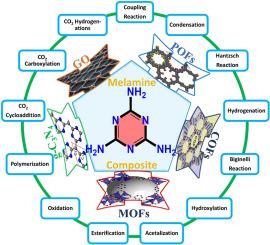Melamine-based materials and composites for catalytic applications in organic synthesis
IF 7.9
3区 材料科学
Q1 GREEN & SUSTAINABLE SCIENCE & TECHNOLOGY
引用次数: 0
Abstract
The development of efficient, stable, and environmentally benign catalysts advances sustainable organic synthesis. Among emerging materials, melamine, a low-cost, nitrogen-rich heterocycle, has attracted significant attention for its ability to form functional composites with a wide range of advanced materials, including porous organic frameworks (POFs), covalent organic frameworks (COFs), metal-organic frameworks (MOFs), graphene oxide (GO), and graphitic carbon nitride (g-C3N4). These materials benefit from melamine's structural versatility, high nitrogen content, and its ability to coordinate with metal centers, making them highly suitable platforms for heterogeneous catalysis. This review provides a comprehensive overview of recent progress in melamine-based composite catalysts, focusing on their structural design, physicochemical properties, and catalytic performance in key organic transformations, such as coupling, condensation, hydrogenation, oxidation, and CO2 conversion reactions. Particular emphasis is placed on synthetic strategies, structure-activity relationships, and advantages including recyclability, high surface area, and tunable porosity. By mapping the current landscape of melamine-derived catalytic materials and elucidating their mechanistic roles in green chemistry, this review aims to inspire future research and foster innovation at the intersection of materials science and catalysis.

三聚氰胺基材料及其复合材料在有机合成中的催化应用
高效、稳定、环保催化剂的开发促进了可持续有机合成。在新兴材料中,三聚氰胺是一种低成本、富氮的杂环,因其与多种先进材料(包括多孔有机框架(POFs)、共价有机框架(COFs)、金属有机框架(MOFs)、氧化石墨烯(GO)和石墨化碳氮化(g-C3N4))形成功能复合材料的能力而受到广泛关注。这些材料得益于三聚氰胺结构的通用性、高氮含量以及与金属中心协调的能力,使其成为非常适合多相催化的平台。本文综述了近年来三聚氰胺复合催化剂的研究进展,重点介绍了三聚氰胺复合催化剂的结构设计、物理化学性质以及在偶联、缩合、加氢、氧化和CO2转化等关键有机转化中的催化性能。特别强调的是合成策略、结构-活性关系以及可回收性、高表面积和可调孔隙率等优势。通过绘制三聚氰胺衍生催化材料的现状,阐明其在绿色化学中的机制作用,本文旨在启发未来的研究和促进材料科学与催化交叉领域的创新。
本文章由计算机程序翻译,如有差异,请以英文原文为准。
求助全文
约1分钟内获得全文
求助全文
来源期刊

Materials Today Sustainability
Multiple-
CiteScore
5.80
自引率
6.40%
发文量
174
审稿时长
32 days
期刊介绍:
Materials Today Sustainability is a multi-disciplinary journal covering all aspects of sustainability through materials science.
With a rapidly increasing population with growing demands, materials science has emerged as a critical discipline toward protecting of the environment and ensuring the long term survival of future generations.
 求助内容:
求助内容: 应助结果提醒方式:
应助结果提醒方式:


